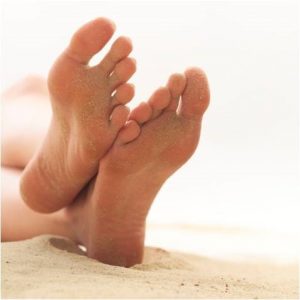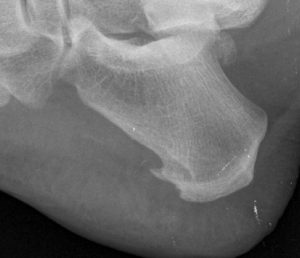
The heel bone is the largest of the 26 bones in the human foot, which also has 33 joints and a network of more than 100 tendons, musc
les, and ligaments. The heel bone is unique because it is responsible for transfering all of your weight from your legs to your feet. Heel pain, sometimes disabling, can occur in the front, back, or bottom of the heel.
Heel pain has many causes. Heel pain is generally the result of faulty biomechanics (walking abnormalities) that place too much stress on the heel bone and the soft tissues that attach to it. The stress may also result from injury, or a bruise incurred while walking, running, or jumping on hard surfaces; wearing poorly constructed footwear (such as flip flops); or being overweight.
Common causes of heel pain include:

Heel Spurs: A bony growth on the underside of the heel bone. The spur, visible by X-ray, appears as a protrusion that can extend forward as much as half an inch. When there is no indication of bone enlargement, the condition is sometimes referred to as “heel spur syndrome.” Heel spurs result from strain on the muscles and ligaments of the foot, by stretching the long band of tissue that connects the heel and the ball of the foot, and by repeated tearing away of the lining or membrane that covers the heel bone. These conditions may result from biomechanical imbalance, running or jogging, improperly fitted or excessively worn shoes, or obesity.
 Plantar Fasciitis: This condition occurs when the plantar fascia is strained over time beyond its normal extension, causing the soft tissue fibers of the fascia to tear or stretch at points along its length; this leads to inflammation, pain, and possibly the growth of a bone spur where the plantar fascia attaches to the heel bone. The inflammation may be aggravated by shoes that lack appropriate support, especially in the arch area, and by the chronic irritation that sometimes accompanies an athletic lifestyle.
Plantar Fasciitis: This condition occurs when the plantar fascia is strained over time beyond its normal extension, causing the soft tissue fibers of the fascia to tear or stretch at points along its length; this leads to inflammation, pain, and possibly the growth of a bone spur where the plantar fascia attaches to the heel bone. The inflammation may be aggravated by shoes that lack appropriate support, especially in the arch area, and by the chronic irritation that sometimes accompanies an athletic lifestyle.
Resting provides only temporary relief. When you resume walking, particularly after a night’s sleep, you may experience a sudden elongation of the fascia band, which stretches and pulls on the heel. As you walk, the heel pain may lessen or even disappear, but that may be just a false sense of relief. The pain often returns after prolonged rest or extensive walking.
Other possible causes of heel pain include:
- rheumatoid arthritis and other forms of arthritis, including gout, which usually manifests itself in the big toe joint;
- an inflamed bursa (bursitis), a small, irritated sac of fluid; a neuroma (a nerve growth); or other soft-tissue growth. Such heel pain may be associated with a heel spur or may mimic the pain of a heel spur;
- Haglund’s deformity (“pump bump”), a bone enlargement at the back of the heel bone in the area where the Achilles tendon attaches to the bone. This sometimes painful deformity generally is the result of bursitis caused by pressure against the shoe and can be aggravated by the height or stitching of a heel counter of a particular shoe;
- a bone bruise or contusion, which is an inflammation of the tissues that cover the heel bone. A bone bruise is a sharply painful injury caused by the direct impact of a hard object or surface on the foot.
- Stress fractures, commonly caused by excessive physical activity are another cause of heel pain that must be ruled out by a podiatrist.
Santi Podiatry Group is here to help! No one should suffer from heel pain on a daily basis. Early diagnosis and treatment are necessary to help alleviate your pain and prevent recurrence.
Early treatment might consist of padding, strapping, injections, proper stretching exercises, physical therapy, and the use of a function foot orthoses to help support the foot and place stressed muscles and tendons into a more physiologically restful state.
Only a relatively few cases of heel pain require more advanced treatments or surgery if treatment is not initiated early enough.
Contact us today for more information!